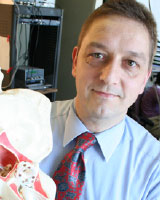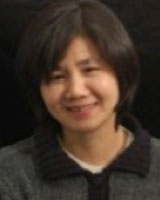Our Labs
The labs within the Department of Otolaryngology - Head & Neck Surgery at Northwestern University Feinberg School of Medicine conduct regular research to build on our understanding of our subspecialties and the conditions we treat. Learn more about the work being done in our individual labs via the links below.
Auditory Research Laboratory
Principal Investigator
 Claus-Peter Richter, MD, PhD
Claus-Peter Richter, MD, PhD
cri529@northwestern.edu
Areas of Research
Development of cochlear implants including novel devices based on neural infrared stimulation, use of laser in clinical settings, micromechanics of the cochlea, imaging, medical device development.
Current Research
The interest of my group is to characterize the function of the normal inner ear, to compare it to the function of a damaged ear, and to develop means and strategies to alleviate hearing impairment. Cutting edge studies include: experiments on cochlear micromechanics, cochlear soft tissue imaging with hard X-rays, research on redesigning cochlear implant devices which use light for neural stimulation, and the development and testing of novel laser sources. In particular, the lab’s recent work on the development of laser based cochlear implants has attracted the interest of many researchers, engineers, and practitioners. Our lab was the first to explore optical radiation as a means of stimulating auditory neurons as an alternative to electrical stimulation, using and studying this novel approach since 2004. In NIH and DoD funded projects, we have determined basic laser parameters that allow us to safely stimulate auditory neurons over several hours. Together with an industrial partner, laser units that are chronically implantable in a cat animal model were developed and tested. Behavioral results from implanted cats demonstrate that the animals receive an auditory input. Our goal is to further the technology towards a human device.
Auditory Molecular & Cell Biology Laboratory
Principal Investigator
 Jing Zheng, PhD
Jing Zheng, PhD
jzh215@northwestern.edu
Areas of Research
Cell biology, hearing sciences, molecular neuroscience
Current Research
Mammalian hearing requires outer hair cells (OHCs) to amplify sound signals mechanically, resulting in high sensitivity and sharp frequency selectivity. In my lab, we are investigating molecules related to OHCs that play essential roles in mammalian hearing. We are exploring several key proteins that are important for hearing: (1) Prestin, the OHC motor protein required for cochlear amplification to achieve high sensitivity and sharp frequency selectivity for mammalian hearing (Zheng et al., Nature, 2000); (2) CEACAM16, an adhesive protein of the tectorial membrane required for delivering OHC mechanical feedback and amplification. Mutation of CEACAM16 causes DFNA4B (Zheng et al., PNAS, 2011); (3) CAMSAP3, a microtubule-binding protein involved in many cellular functions, including motile cilia formation (Robinson et al., PNAS, 2020). Our research has found that animals with a knock-down of CAMSAP3 protein display signs and symptoms similar to primary ciliary dyskinesia, including hydrocephalus, subfertility, hyposmia, anosmia, rhinosinusitis, otitis media, and hearing loss.
Hearing loss is a common sensory defect affecting millions around the world. Factors such as noise, age, and ototoxic drugs can cause stress in hearing organs, leading to cochlear damage, including loss of OHCs. However, our current hearing measurements cannot detect low-level cochlear damage reliably, and it is impossible to identify cochlear stress before irreversible tissue damage and hearing loss have already occurred. Since OHCs are highly vulnerable to various insults, we are investigating whether OHC-specific proteins can be used as biomarkers to detect cochlear stress and damage. These studies will also enhance our understanding of cochlear physiology at the molecular level and allow us to develop improved strategies to prevent hearing loss.
Cochlear Drug Discovery Laboratory
Principal Investigator

Donna Whitlon, PhD, Research Professor
whitlon@northwestern.edu
NU Scholars Profile
Areas of Research
Drug Discovery for Hearing Loss; Noise Induced Hearing Loss; Nerve Fiber Regeneration; Mechanisms of Neurite Growth
Current Research
The Whitlon Lab is actively engaged in research aimed at developing drugs for hearing loss by examining cochlear nerve fiber regeneration in culture models, by examining promising drugs in animal models of noise induced hearing loss, and by elevating promising drugs to clinical trial.
Our group studies ways to prevent or repair hearing loss, which is a significant medical problem. According to the National Institute for Deafness and Other Communicative Disorders (NIDCD), approximately 17% of American adults report some degree of hearing loss. In the group that are 75 years of age and older, more than 45% have a hearing loss. However, at present, there are no drugs that are FDA approved to treat this problem. As hearing loss can interfere with communication, socialization, work efficiency, and other aspects of health, it is critical that interventions be developed to prevent or repair hearing loss.
In a novel cell culture system using newborn mouse cochlear neurons, we found that some members of the statin class of drugs stimulate regeneration of damaged cochlear nerve fibers. We elevated one member of that family, fluvastatin, to evaluation in a guinea pig model of noise induced hearing loss and found that it also protects against hearing loss as well as protects the sensory cells, the hair cells, from degeneration. We have found a similar result in mice. These studies set the stage for a clinical trial of statins and sudden hearing loss, begun in February 2023.
Pediatric Airway Research Laboratory
Principal Investigator

James W. Schroeder, Jr., MD, Associate Professor
jschroeder@luriechildrens.org
Areas of Research
My research focuses primarily on conditions that lead to airway obstruction in children as well as the feeding and swallowing disorders that can accompany these conditions and their treatments. I also am interested in pediatric obstructive sleep apnea and its causes, diagnosis and treatments.
Current Research
I perform primarily clinical research that focuses on conditions that lead to airway obstruction in children as well as the feeding and swallowing disorders that can accompany these conditions and their treatments. I am also collaborating with the division of Sleep Medicine at CMH on several retrospective and prospective sleep apnea studies. My translational research interests include studying the role of salivary amylase and pepsin found in the bronchial secretions in children with and without tracheotomy. I am working with the Departments of Otolaryngology and Allergy and Immunology at Feinberg looking at inflammatory mediators in children with chronic sinusitis and nasal polyposis as part of a larger adult study funded by an NIH grant.
Northwestern University Sinus & Allergy Center
Principal Investigator

Bruce K. Tan, MD, Associate Professor
Irene and Walter Wayne Templin Professor
Areas of Research
Immunopathogenesis of chronic sinusitis, biomarkers for determining outcome in chronic sinusitis, evidence-based medicine, clinical outcomes, clinical trials.
Current Research
I am a clinician-scientist whose research interests are to understand the molecular and immunopathologic changes found in chronic rhinosinusitis (CRS) and their impact on clinical outcomes. The ultimate long term goal of my work is to find novel means to treat patients with this disease. CRS is a chronic and debilitating inflammatory condition of the nose and paranasal sinuses that affects millions of adults. Since there is little known about the pathobiology of this common disease, my research, in conjunction with the Northwestern University Sinus and Allergy Center, takes a multi-pronged approach.
Understanding B-cell and antibody responses in CRS
In the subtype of CRS associated with nasal polyp formation (CRSwNP), there is extensive activation of B-cells and their consequent antibody responses. This is driven by molecular factors including the over-expression of related chemokines and cytokines such as BAFF (Kato et al., JACI 2008). Evidence for dysregulation of their antibody responses can be found in the production of locally elevated levels of self-reactive autoantibodies that are predictors of nasal polyp recurrence after surgery (Tan et al, JACI 2011; Jeffe et al, Laryngoscope 2013; van Roey et al JACI 2017, Eide et al CEA 2022; Bai et al, JACI 2022). Our NIH funded research focuses on understanding the specificities of these autoantibodies, understand mechanisms driving the activation of B-cells in nasal polyps and circulation and studying their potential to serve as biomarkers for more aggressive, treatment resistant varieties of CRS.
Understanding the molecular mechanisms of Type 2 inflammation
CRS is among the most common causes of reversible smell loss in patients but yet about half the patients do not reliably regain their sense of smell following treatment. The mechanism by which this smell loss occurs is yet unknown but appears to be a combination of conductive effects and direct damage to the olfactory region. We have found that Type 2 inflammation characterized by eosinophils, and the cytokines IL-5 and IL-13 are the strongest predictors of smell loss in patients with CRS (Thompson et al, IFAR 2016; Lavin et al, Laryngoscope 2017; Min et al, JACI 2017). Our research focuses on how endoscopic sinus surgery changes Type 2 inflammation (Harmon JACI 2023) causes epithelial and olfactory neuroepithelial damage and pharmacologic strategies to reverse these changes. We additionally seek to understand predictors of olfactory restoration following treatment using endotyping strategies.